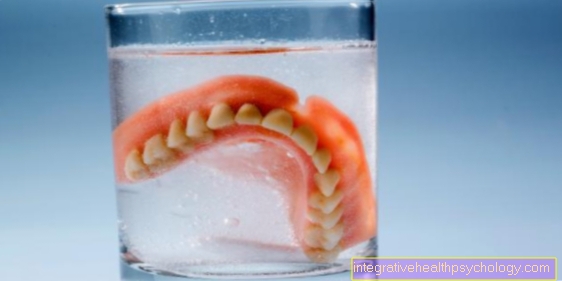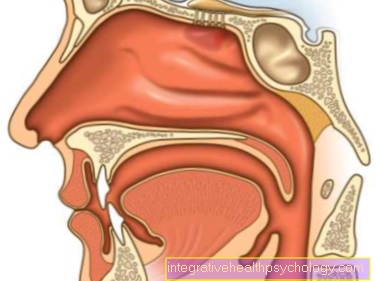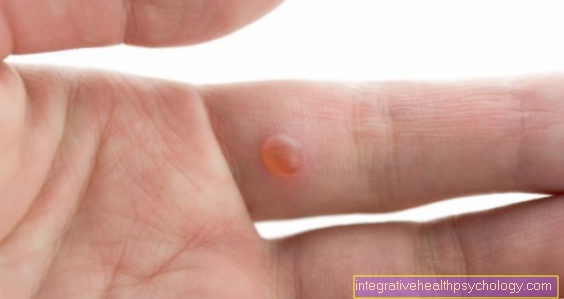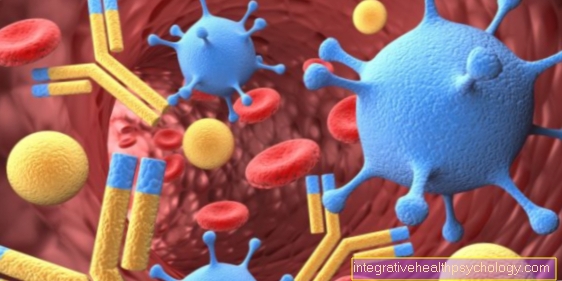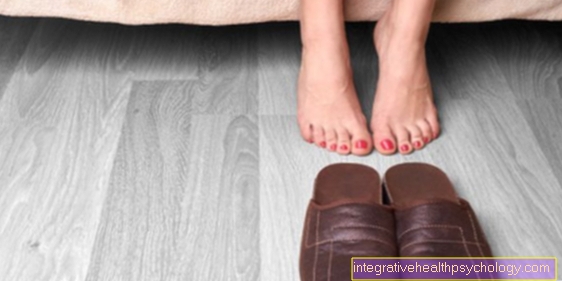Eyelid inflammation
introduction
The medical term for eyelid inflammation is blepharitis. A spread of the inflammation to the conjunctiva (conjunctivitis) can often be observed. But only certain parts of the eyelid can be inflamed, for example the corner of the eyelid or the bags under the eyes (Dacryocystitis). The eyelid serves to protect the eye from drying out and external influences. On the inside, the eyelids are covered by the conjunctiva and the eyelashes, which protect the eye from dirt, are located on the edges of the eyelids. In the area around the eyelashes there are various types of sweat and sebum glands that prevent tear fluid from overflowing the edge of the eyelid. These glands can become inflamed, which can cause severe pain. Inflammations on the eyelid can be divided into different groups depending on their cause.
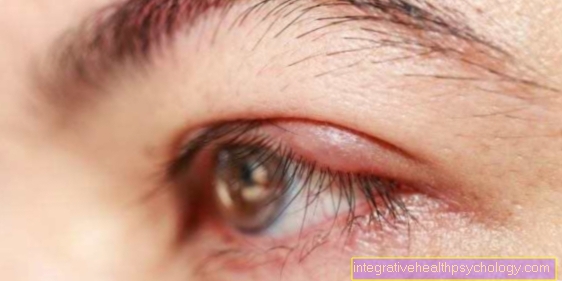
General
A distinction is made between scaly eyelid inflammation, which occurs, for example, as part of a general skin disease, and infectious eyelid inflammation, which is usually caused by bacteria, viruses (e.g. herpes viruses) or fungi. In addition, an allergic reaction such as a reaction to incompatible cosmetics, house dust or pollen can cause eyelid inflammation. A special and widespread symptom is the stye under the eyelid inflammation, which is usually caused by a bacterial infection.
Detecting eyelid inflammation
What are the symptoms of eyelid inflammation?
The symptoms of eyelid inflammation can vary significantly depending on the area affected. The eyes may itch and water, but in severe cases it can also lead to massive pain and increasing loss of vision. In most cases, eyelid inflammation is characterized by a noticeable reddening and swelling of the eyelids (see also: Eyelid swelling). The swelling is accompanied by severe itching and possibly also a painful burning sensation. Depending on how pronounced the eyelid inflammation is, the eyelashes stick together and the eyelashes may even fall out.
In some cases there is also pain in the corner of the eye. In many cases there is pronounced irritation of the eyes and eyelids, which can be combined with a feeling of foreign bodies (e.g. like "sand" in the eyes). Sensitivity to the incidence of light and increased tearing of the eyes are also frequently observed.
If it is an inflammation of the eye sac, the inner corner of the eyelid is usually very red, swollen and painfully sensitive to pressure. At the inner corner of the eyelid there are the so-called teardrop points, through which pus can repeatedly escape. In some cases, an abscess, a cavity of pus, can form, which can lead to serious impairments and consequences (e.g. the development of a life-threatening inflammation of the brain). The collection of pus can also form an open connection to the lid, which is known as a lacrimal sac fistula. If the lacrimal gland is inflamed (Dacryoadenitis) there is a severe, painful swelling of the eyelid and often an abscess formation as well.
This article might also interest you: The itchy eyelid.
itching
Eyelid inflammation is often very itchy. Be careful not to rub your eyes. This usually increases the itching and the infection can spread through spreading of bacteria. The ophthalmologist often prescribes antihistamines to help relieve itching.
Pain
Another accompanying symptom of eyelid inflammation is pain in the eyelids. They are often associated with swelling and redness of the eye. If you experience severe pain, you should immediately consult an ophthalmologist.
How is eyelid inflammation diagnosed?
An eyelid inflammation is usually clearly visible from the outside and a diagnosis can often be made based on the appearance and description of the symptoms. There are numerous ophthalmological examination methods available for a clear assessment of the inflammation. Often, for example, microscopic examinations of the various eye sections with the help of a so-called slit lamp are used. The reflection of the fundus through a special magnifying glass (Ophthalmoscope) is often used to rule out the possibility that the inflammation has spread to other parts of the eye. If the inflammation is caused by bacteria, viruses or fungi, it may be necessary to determine the pathogen in the laboratory. A blood test can also help, for example if there are general diseases or systemic infectious diseases.
An allergy test can provide further information for the diagnosis if an allergic reaction, for example to cosmetics, is suspected. Eyelid inflammation should not be taken lightly as, in the worst case, it can lead to loss of vision. For this reason, an ophthalmologist should always be consulted if the symptoms are unclear. Even supposedly harmless inflammations such as a stye should be examined by a doctor if they do not subside on their own after a few days.
Causes of eyelid inflammation
Stye
A stye can be the cause of painful eyelid inflammation. A stye is an acute bacterial inflammation of an eyelid gland. There is swelling in the affected area, pain and severe redness. There is also a central point of pus.
A distinction is made between an outer and an inner stye. In the case of the outer stye, the glands on the edge of the eyelid are affected and the inflammation is clearly visible. With an internal stye, the eyelid glands on the inside of the eyelid are inflamed. The eyelid can swell outward, but the swelling is often not associated with stye.
Find out more about the topic: Stye
Rosacea
Rosacea is a chronic inflammation of the skin on the face. The middle third of the face is often affected. Symptoms such as redness, the formation of small veins, and inflammatory papules and pustules appear. In the course of the disease, the eyes are often involved.
Patients often have eyelid inflammation and conjunctivitis. In these cases one speaks of ocular rosacea. In rare cases it can lead to blindness. If you have rosacea, you should have your eyes checked regularly by an ophthalmologist.
Read more on the topic: Rosacea
allergy
An allergy can also cause eyelid inflammation. The allergic reaction is often triggered by care products or cosmetics. It can also be triggered by an intolerance to eye drops or eye ointments or other allergens such as pollen or house dust mites.
Typically, an allergic eyelid inflammation occurs over the entire eyelid, like a balloon (eyelid edema).
This article might also interest you: Eyelid swelling
Dry skin
Patients with very dry and flaky skin are more likely to experience eyelid discomfort. In atopic dermatitis (neurodermatitis) and seborrheic dermatitis (seborrheic eczema), eyelid inflammation is often an accompanying symptom. In atopic dermatitis, the eyelids are swollen, red, and itchy. The skin is prone to cracks and blisters.
Read more on the topic: Atopic dermatitis
In seborrheic dermatitis, a whitish-yellowish, oily rash forms on the scalp, face, around the ears, and on the eyelids. The secretion of the eyelid margin glands congestion, the eyelash roots usually crust yellowish and the eyelid becomes inflamed by bacterial skin germs.
Further information on the subject can be found at: Seborrheic eczema
Treating eyelid inflammation
How is eyelid inflammation treated?
The therapy depends on the cause of the eyelid inflammation and can therefore differ significantly from case to case. For example, antibiotic treatment is used for bacterial inflammation. In principle, moist and disinfecting compresses can provide relief from inflammation of the eyelid and promote the healing process, but should not be used if the cause is bacterial or viral.Here the spread of the pathogens and an expansion of the inflammation to other areas of the eye threatens. Eye drops and pain relievers are also used to relieve the symptoms. If the eyelid inflammation is caused by viruses or fungi, drugs against the respective pathogens can also be considered. Allergic inflammation is mainly treated by avoiding contact with the allergens.
If the eyelid inflammation is caused by a stye, the stye usually breaks up within a few days and the inflammation then heals on its own. In some cases, the stye does not break open, then the pus cannot drain and under certain circumstances an eyelid abscess can form. In this case, the stye must be surgically opened and the accumulation of pus removed. Inflammation of the tear sac can also lead to abscess formation, which must be treated surgically.
A so-called eyelid hygiene can help to ensure the normal drainage of the secretion produced by the eyelid glands. The eyelids are first warmed, which can be achieved, for example, with the help of warm compresses or infrared light. Then the ducts of the sebum glands on the edge of the eyelid are massaged with clean fingers or cotton swabs, which allows the secretion to drain and the blockage to be removed. Existing adhesions and crusts on the edges of the eyelids should also be carefully removed on a regular basis, for example with a damp cloth or a special cleaning solution.
Which ointments help best?
If you suspect eyelid inflammation, you should see an ophthalmologist. As a rule, the doctor will prescribe a disinfectant or locally anti-inflammatory eye ointment containing cortisone (Hydrocortisone-POS® N 1% eye ointment), which you apply for 10-14 days. The Posiformin® 2% eye ointment with the active ingredient bibrocathol is particularly suitable as a disinfectant ointment for inflammation of the eyelid margin.
Further information on the subject can be found at: Eye ointment with cortisone
If the doctor diagnoses bacterial eyelid inflammation, you will be prescribed an eye ointment containing antibiotics such as Oxytetracyclin® Jenapharm eye ointment for 2-6 weeks. If the eyelid inflammation is resolved by a viral infection, an eye ointment with an anti-viral agent (aciclovir), such as Zovirax® eye ointment or Virupos® eye ointment, is used. Eye drops (such as Azelastin® or Cromoglicin®), which inhibit an allergic reaction, are usually also prescribed.
Read more on the topic: Acyclovir eye ointment
Which home remedies can help?
With an eyelid inflammation, you should pay special attention to hygiene. Clean and massage your eyelid margins regularly, otherwise your pores will clog again. The eyelid care improves the drainage of fat from the glands. To do this, you should massage the edge of the eyelid along the upper and lower edge of the eyelid two to three times a day. A cotton swab or a moistened cosmetic tissue is suitable for massage and cleaning.
Another home remedy that can help with eyelid inflammation is heat. You can make moist, warm compresses with a washcloth or use a heat gel mask and warm cotton pads. You can also use a red light lamp. This should have a temperature between 38 and 45 degrees. During heat therapy, the secretion is liquefied and can flow away more easily. If you do heat therapy about 10 minutes.
homeopathy
In the case of eyelid inflammation, you can use homeopathic remedies depending on the cause and symptoms. The drug of choice for inflammatory or allergic processes with involvement of the eyes is Euphrasia in the potency D12. Euphrasia (also called eyebright) is a native plant and contains antibacterial and anti-inflammatory substances.
You should be careful with the use of chamomile for eye inflammation, as chamomile can cause allergic reactions on the eye.
Read more on the topic: Euphrasia eye drops- how do they work?
How contagious is eyelid inflammation?
In principle, there is no great risk of infection from eyelid inflammation. If the eyelid inflammation is triggered by bacteria, it is one of the contagious clinical pictures, but the risk of infection is rather low in contrast to conjunctivitis.
If only one eyelid is inflamed, you should take hygiene measures to ensure that the second eye does not become infected as well. If you rub your eyes with your fingers, the bacteria can spread and spread the infection.
Preventing eyelid inflammation
What are the causes of eyelid inflammation?
Various causes of eyelid inflammation are summarized under the term "stye". A distinction is made between an outer stye (External hordeolum) and an inner (Hordeolum internum). In the former, either the minor glands, which are sweat glands on the eyelid, or the Zeis glands, which are sebum glands, are inflamed. An inner stye is an inflammation of the meibomian glands, also sebum glands, but which are located on the edge of the eyelid. In most cases, a stye is caused by a bacteria (usually staphylococci, occasionally streptococci). It is a relatively harmless disease as no serious health problems are to be expected. However, a frequent recurrence of stye can indicate a general weakness of the body's immune system (e.g. diabetes, diabetes).
A further cause of an eyelid inflammation is an inflammation of the lacrimal sac. The so-called dacryocystitis is usually caused by a drainage disorder of the tear fluid, which leads to an excessive multiplication of bacteria inside the lacrimal sac. The situation is similar with an inflammation of the lacrimal gland.
How can you prevent eyelid inflammation?
The use of cosmetics around the eyes can lead to inflammation of the eyelids. Especially when it comes to repeated inflammation, cosmetics should not be used in the eye area or checked for tolerance. Wearing contact lenses is also a risk factor for the development of eyelid inflammation. Contact lenses can bring bacteria and fungi into the eye area and also form a humid chamber, which is a perfect breeding ground for the pathogens. After wearing, contact lenses should always be cleaned thoroughly with a care solution. They should also not be worn longer than intended, as the risk of bacterial contamination increases with prolonged use.
Basically, the eyes should be protected from particular stress in order to effectively prevent inflammation of the eyelid. Drafts, dry air, dust, smoke, strong sunlight, cold, heat or too little light weaken the eye and pathogens can penetrate more easily.
Course of an eyelid inflammation
How long does eyelid inflammation last?
The duration of eyelid inflammation depends on the severity of the disease. It can be acute or chronic. Chronic inflammation is mostly seen in people with excessive secretion production.
Acute eyelid inflammation should heal within a few weeks. The chronic form, on the other hand, can usually only be alleviated through consistent and daily eyelid margin hygiene so that it occurs less frequently.
What is the prognosis for eyelid inflammation?
Usually the prognosis for eyelid inflammation is good. However, in some cases the disease progresses persistently. Especially in people who have excessive sebum production, eyelid inflammation can often only be cured permanently with very consistent eyelid hygiene.
Serious courses or serious complications of the disease rarely occur, but a harmless eyelid inflammation can also develop into a pus abscess or deeper skin injuries. If left untreated, this can lead to permanent eyelid misalignments, as scar tissue develops, which warps the edge of the eyelid outwards or inwards.
Further information
For more information on eyelid inflammation, visit:
- Inflammation of the eyelid
- Inflammation of the upper eyelid
- Inflammation of the lower eyelid
- Stye
- Infection of the eye
- Hailstone
















